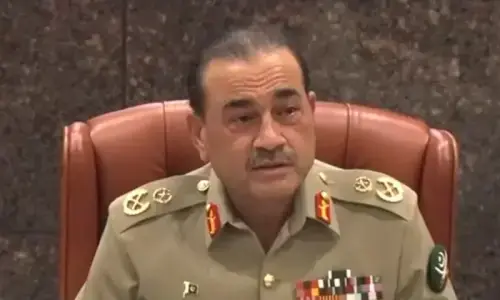Pakistan ranks 10th among largest importers of major arms globally: report

Pakistan was among the biggest importers of major arms in Asia and Oceania from 2016-2020 while globally it ranked 10th, accounting for 2.7 per cent of major arms imports, a report published by the Stockholm International Peace Research Institute (Sipri) said on Monday.
The five largest major arms importers in the time period under consideration were Saudi Arabia, India, Egypt, Australia, and China.
Among them, Saudi Arabia accounted for 11pc of global imports; India 9.5pc; Egypt 5.8pc; Australia 5.1pc; and China 4.7pc. Pakistan accounted for 2.7pc of major arms imports in the five years from 2016 to 2020.
Pakistan and India
Pakistan's main supplier during this time was China, which accounted for 74pc of the country's imports, followed by Russia (6.6pc) and Italy (5.9pc). Compared to the previous period, Pakistan saw a 23pc decrease in arms imports.
In comparison, India's main suppliers during this time period were Russia (49pc), France (18pc) and Israel (13pc). The neighbouring country also saw a 33pc decrease in its total imports from 2016-2020 versus the first five years of the decade.
Another notable change in India's imports came from the United States, which was the second-biggest supplier of arms to the country in the first five years of the decade, but fell to the fourth spot after its exports dropped by 46pc. India's arms imports from France increased by 709pc during this time, while imports from Israel grew 82pc.
The report noted that the reasons behind the decrease in India's overall arms imports included the lengthy process of procurement, its attempt to reduce dependence on exports from Russia, and its plans to start its own production. However, since its own production programme is facing delays, India is instead planning several large-scale orders of arms so its imports are likely to increase over the next five years.
Meanwhile, the report noted that Pakistan had several large outstanding orders for arms that are scheduled to be completed by 2028. The orders include 50 combat aircraft, eight submarines and four frigates from China, and four frigates from Turkey.
Asia and Oceania was the largest importing region for major arms, receiving 42 per cent of global arms transfers in 2016–2020. In addition to Pakistan, India, Australia, China and South Korea were also among the biggest importers in the region.
“For many states in Asia and Oceania, a growing perception of China as a threat is the main driver for arms imports,” said Siemon Wezeman, Senior Researcher at Sipri.
Global arms exports flat
The report noted that international deliveries of arms were flat in the period 2016-2020, ending more than a decade of increases.
The United States, France and Germany — three of the world’s biggest exporters — increased deliveries, but falls in exports from Russian and China offset the rise, Sipri said.
Exports by China, the world’s fifth-largest arms exporter in 2016–20, decreased by 7.8pc between 2011–2015 and 2016–2020. Chinese arms exports accounted for 5.2pc of total arms exports in 2016–2020. Pakistan, Bangladesh and Algeria were the largest recipients of Chinese arms.
It was the first time since 2001–2005 that the volume of deliveries of major arms between countries — an indicator of demand — did not increase from the previous five year period, Sipri said.
While the pandemic has shut down economies across the world and pushed many countries into deep recessions, Sipri said it was too early to tell whether the slowdown in arms deliveries was likely to continue.
“The economic impact of the Covid-19 pandemic could see some countries reassessing their arms imports in the coming years,” Pieter Wezeman, senior researcher with the Sipri Arms and Military Expenditure Programme, said in a statement.
“However, at the same time, even at the height of the pandemic in 2020, several countries signed large contracts for major arms.”
The United Arab Emirates, for example, recently signed an agreement with the United States to purchase 50 F-35 jets and up to 18 armed drones as part of a $23 billion package.
Middle Eastern countries accounted for the biggest increase in arms imports, up 25pc in 2016–2020 from 2011–15.
Saudi Arabia, the world’s biggest arms importer, increased its arms imports by 61pc and Qatar by 361pc.

































